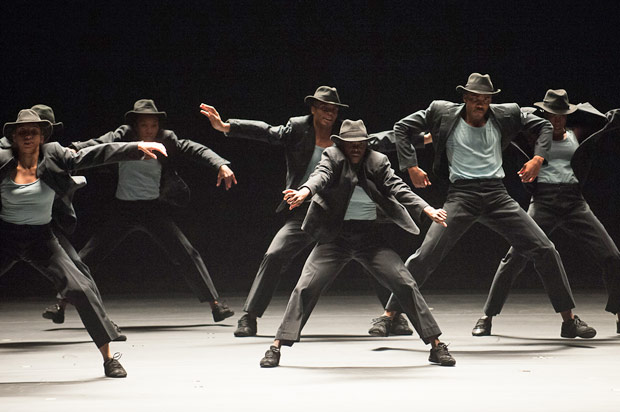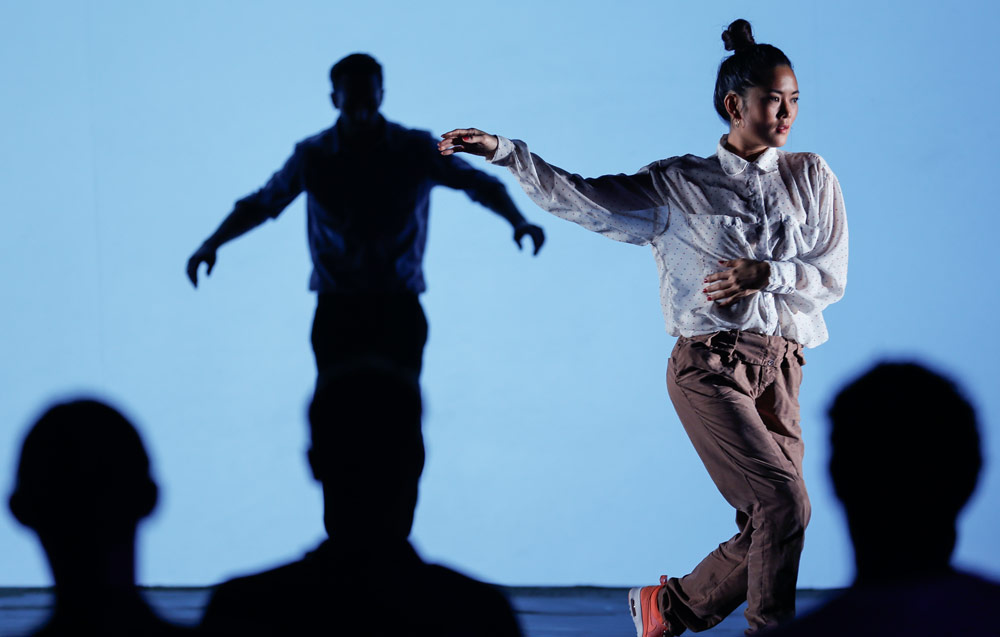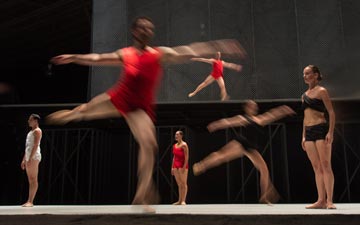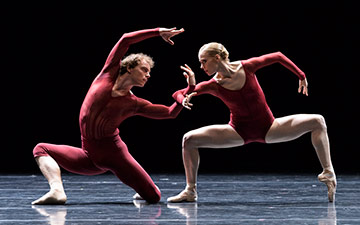
© Christopher Duggan. (Click image for larger version)
Fall For Dance Festival – Program 2
Lucinda Childs Dance: Concerto
Semperoper Ballett Dresden: Neue Suite
Wang Ramirez – Sebastien Ramirez & Honji Wang: AP15
Alvin Ailey American Dance Theater: Minus 16
New York, City Center
11 October 2012
nycitycenter.org
In bestowing Alvin Ailey American Dance Theater with Minus 16, Israeli choreographer Ohad Naharin has given the troupe its new Revelations. On Saturday night’s program for Fall For Dance Festival at City Center, the company – currently under the direction of Robert Battle – is in their element. The stirring, electrifying piece juxtaposes the sacred with the celebratory, culminating in a rapturous finale. While the work has gone viral in popularity and is performed by other groups, it is hard to believe Minus 16 – which draws on excerpts from several of Naharin’s other works – looks this good on any other company.
The theatre lights are still up when a tall, svelte man (Samuel Lee Roberts) appears, standing in front of the curtain and staring out beyond the audience. Some jazz plays. He fidgets. He bops to the music, then stops himself. He lunges suddenly, then puts himself back into place. His body gets away from him. The outbursts continue, his legs and arms and hips gradually giving in to the music, at first with reservation, then with rapture. It is an exercise in refined, vaudevillian physical comedy. Children in the audience giggle as if they’re at the circus. As with all good comedy, various subtexts surface: that we take ourselves too seriously and that dance and music are universal miracles, miracles worth celebrating.

© Paul Kolnik. (Click image for larger version)
Naharin’s famous “chair dance” soon takes over. A half-circle of folding chairs curves across the stage. The dancers are all clad in black suits, black hats and white shirts. A voice says: “…the illusion of beauty and a fine line that separates madness and sanity.” A potent, primal, percussive rendition of the Passover song Echad Mi Yode’a plays and, in a rippling roll-off, the dancers fling back with a sudden burst, their white shirts blazing under the stage lights. The roll-offs are interspersed with stillness (dancers seated, heads hanging down between their legs) and spastic, nonsensical gestures (heads bobbing, hands flailing). These abrupt en-masse movements make the work feel volatile, in the best way – a prayer interrupted. The suits – a metaphor for social order – remind us that we are all on the verge: of disobeying, of bursting out of the mold. Gradually dancers shed their clothes, stripping down to short grey pajamas; there is something of the asylum about it. Calm arrives in the form of an achingly beautiful duet, set to an excerpt from Vivaldi’s Stabat Mater and full of contact work.

© Paul Kolnik. (Click image for larger version)
For the finale, serious-faced dancers pluck a variety of audience members – young, old, middle-aged, tall and short – and drag them onstage to rock out, first to a techno remix of Over the Rainbow and then to a variety of jazz and cha-cha. After the initial shock, the “non-dancers” throw themselves into it. An older African-American woman, despite trying to exit the stage several times, proves the audience favorite, and hams it up. When her partner picks her up and twirls her around, she leans back in ecstasy. Sometimes all people need to flower is a platform. Minus 16 and Ailey’s triumphant rendition of it, makes you wonder why we don’t dance with strangers every day.

© The Cool Box. (Click image for larger version)
AP15, an award-winning work choreographed and danced by urban dance collaborators Sébastien Ramirez and Honji Wang, brought the other “wow” factor to Program 2. Set to atmospheric glitch music by Alva Noto and Ryuichi Sakamoto, AP15 is an essay on attraction, tapping initial curiosity, magnetism, repulsion and confusion. The curtain lifts on a seated, backlit Wang, slowly lifting her arms, her billowing blouse translucent in the light. A classically trained hip-hop dancer, her other-worldly grace is the real showstopper. Her movements are smooth and liquid, like pop and locking in slow motion, all economy and no frills. Ramirez and Wang fall into a dialogue: he dances things she does not understand, she mimics, he then tries to impress. Both of them award-winning, groundbreaking artists in their field, this is urban dance and its various incarnations at its most elegant. In an awe-inspiring moment of contact choreography – and there are several – he leaps onto her face. She bends back and bounces up as if her spine was a spring, the cartoon definition of “boing.” For the most part, Wang’s choreography is not passive. She pushes hard on Ramirez’s face with force, as if guiding his every leap and bound. But he then does this to her, and the end result is up for interpretation. Essentially it ends as it started, the two of them moving in their own separate worlds. The conversation has ceased.

© Nika Kramer. (Click image for larger version)
Coming all the way from Dresden, Semperoper Ballett performed Neue Suite, by William Forsythe. An excerpt from the company’s evening-length, all-Forsythe mixed bill, Neue Suite debuted in 2012, but looks like Forsythe remixed rather than new material. A sampling of pas de deux, a lot of it resembles Vertiginous Thrill of Exactitude: fairly upbeat, forcefully cheerful and full of flicky wrists and exaggerated, splayed hands. The Forsythian speed (fast) sees the dancers barely keeping up. Even if this is the intended aesthetic, it looks almost cruel. Dancing with immense command and crispness, Anna Merkulova got the In the Middle, Somewhat Elevated section, all extreme extension, off-kilter strength and Thom Willems music, but she looks great doing it, and proves herself as one to watch.

© Costin Radu. (Click image for larger version)
Concerto from Lucinda Childs Dance is a work of pendulous movement danced by seven dancers in Eileen Fisher-esque outfits. The aesthetic is 2D, as if ballet’s primary poses were flattened by a steamroller. The relentless, minimalist harpsichord concerto by Henryk Gorecki, paired with the constant movement, gives the work a Sisyphean air. It is easy to imagine the dancers performing this, ad infinitum, irrespective of audience, space or time. While the formations change many times, the amount of space between the dancers does not, and this rigid commitment carries the work’s hypnotic effect. By layman’s standards, this is an “abstract” work: there is no story, no fairy tale, no narrative and there are no sets. As with Balanchine – whose “plotless” ballets were considered “abstract” – there is a direct relationship between the dancing and the notes being played. Bodies embody instruments, limbs become the plucked strings, etc. In this way it is no less “literal” than a flowery, twittery Petipa variation, it is merely the manifestation that differs.

















You must be logged in to post a comment.